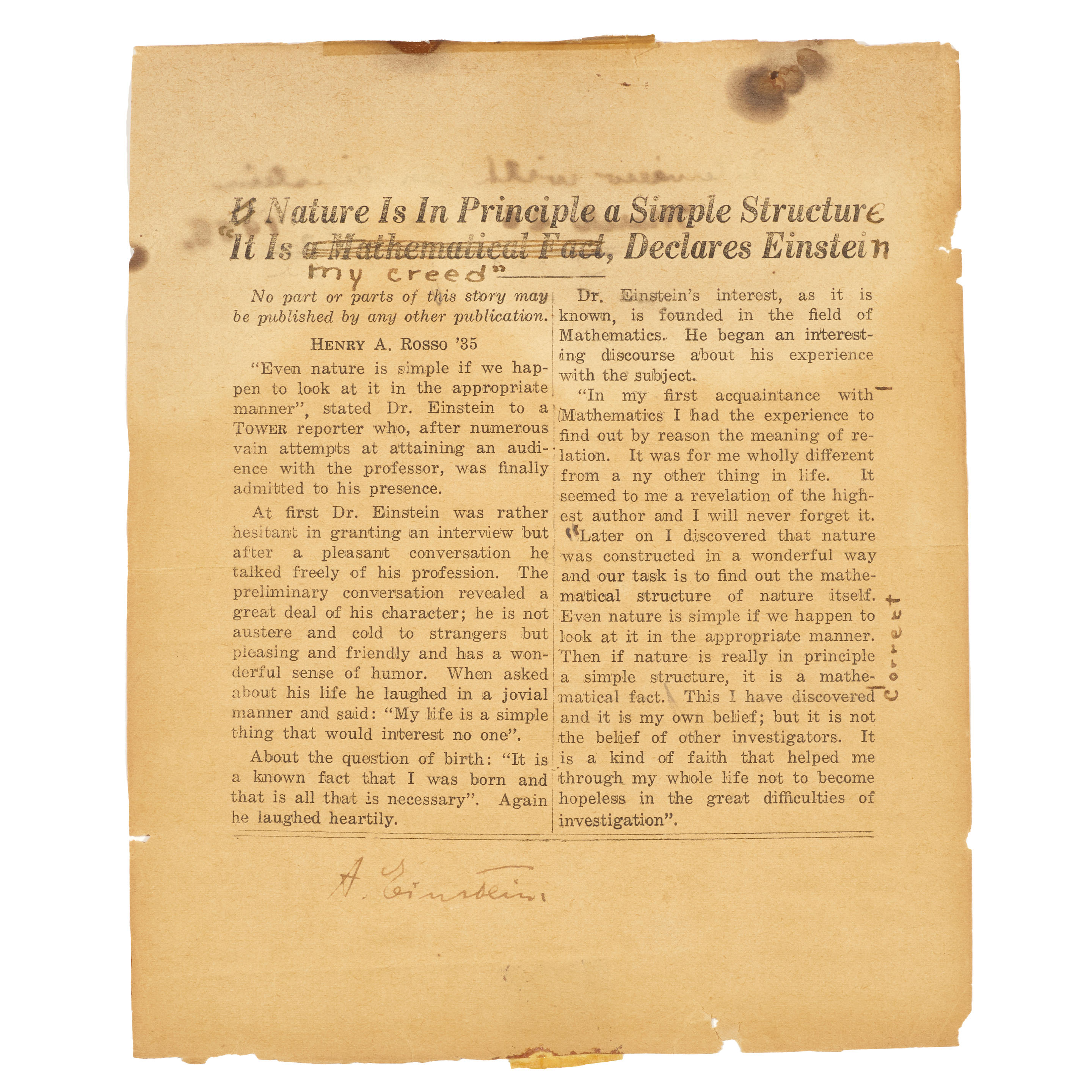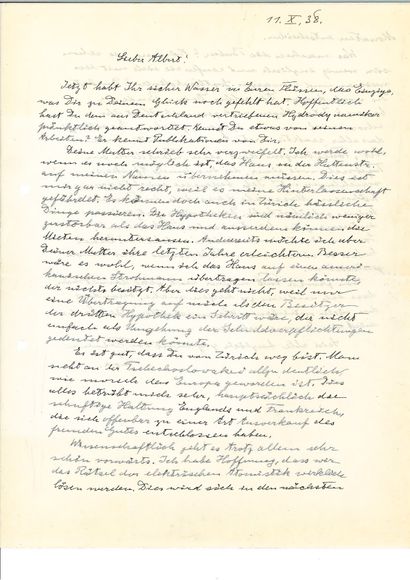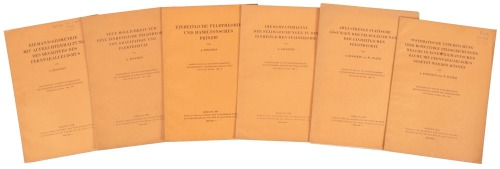EINSTEIN, Albert (1879-1955).] Albert Einstein’s telescope. Manufactured by the Paul Dörffel company, Berlin, late 19th century. A 3¼-inch refracting telescope signed “P.Dörffel Berlin” on the end plate of the 45-inch brass body tube, with a perpendicular eyepiece and a starfinder atop the body tube, supported on an alt-azimuth mount fitted into a mahogany tripod stand with 50-inch legs (some minor knocks and scratches to the body tube commensurate with age and use; lacking the dustcap, and the lens thus with light scratches; replacement screw to starfinder, the mirror diagonal eyepiece by a different maker and a later addition; leather straps for the tripod associated at a later date; one spike supplied [see below]; the optics not tested outdoors but seemingly sound). Provenance : Albert Einstein (gifted to:) – Leo Mattersdorf (1903-1985, by descent to the consignor). Albert Einstein’s telescope: apparently the only scientific instrument owned by Einstein ever offered at auction. Einstein’s revolutionary scientific insights have had a profound impact on our understanding of the universe, and on all those who have turned their gaze or telescope skyward since. A photograph dated circa 1927 shows Einstein in his Berlin study with the telescope in the foreground. It was shipped to America with the rest of Einstein's Berlin furniture when he settled at Princeton in 1933. In 1938 he presented this telescope to his friend Leo Mattersdorf, president of the Amateur Astronomers Association and for many years Einstein’s accountant and tax advisor. Mattersdorf also advised Einstein’s close friend Dr. Gustav Bucky (1880-1963) who introduced the two men soon after Einstein arrived in America. Every year from 1937 Einstein hosted the Mattersdorf family at his Huntington summer house or Princeton home. Later in life Einstein proofread Mattersdorf’s book Insight into Astronomy (New York: 1952). Einstein’s gift was an acknowledgment of this friendship, of a shared passion for astronomy, and of Mattersdorf’s invaluable professional advice. In a letter dated 23 January 1938 retained by Mattersdorf’s heirs, Einstein writes (in German): Dear Mr. Mattersdorf, You have led the struggle for me against the Great Dragon [i.e. the I.R.S.] for years, successfully and indefatigably. And you are also an astronomer. I have a pretty telescope standing in my room: lens diameter 3½ inches; focal length roughly 1½ meters. It sits on a three-footed wooden stand and gives sharp images. As soon as I have a car at my disposal again, I will bring it to you. If you have someone who is going to be passing in the vicinity, he could also pick it up. Best regards, A. Einstein. The letter indicates that Einstein valued his “pretty telescope” and his remark that the optics provide “sharp images” shows that this is an instrument that Einstein used – it was not simply decorative. The photograph of Einstein’s Berlin study circa 1927 confirms that Einstein owned the telescope for at least a decade before the gift, but it’s very likely that he owned it for some time before that: it is mentioned in an interview with the Danish journalist Svend Borberg dated 1926 (in Ekstrabladet , February 1926); the telescope was manufactured in the late-19th century, and the photograph shows that the telescope was already missing one of its spikes when Einstein owned it. The same photograph shows the telescope fitted with an in-line eyepiece; a perpendicular star diagonal of the type now on the telescope makes extended viewing more comfortable, and this was probably fitted by Mattersdorf, or perhaps by Einstein himself. Einstein’s telescope was manufactured by the Paul Dörffel company, Berlin. Dörffel (1843-1897) continued a company founded in 1836 by his father Carl Theodor which also made telescopes, microscopes and surveying equipment, but which became well-known for being among the first in Germany to manufacture Daguerre-principle cameras. Paul built a reputation for preci
EINSTEIN, Albert (1879-1955).] Albert Einstein’s telescope. Manufactured by the Paul Dörffel company, Berlin, late 19th century. A 3¼-inch refracting telescope signed “P.Dörffel Berlin” on the end plate of the 45-inch brass body tube, with a perpendicular eyepiece and a starfinder atop the body tube, supported on an alt-azimuth mount fitted into a mahogany tripod stand with 50-inch legs (some minor knocks and scratches to the body tube commensurate with age and use; lacking the dustcap, and the lens thus with light scratches; replacement screw to starfinder, the mirror diagonal eyepiece by a different maker and a later addition; leather straps for the tripod associated at a later date; one spike supplied [see below]; the optics not tested outdoors but seemingly sound). Provenance : Albert Einstein (gifted to:) – Leo Mattersdorf (1903-1985, by descent to the consignor). Albert Einstein’s telescope: apparently the only scientific instrument owned by Einstein ever offered at auction. Einstein’s revolutionary scientific insights have had a profound impact on our understanding of the universe, and on all those who have turned their gaze or telescope skyward since. A photograph dated circa 1927 shows Einstein in his Berlin study with the telescope in the foreground. It was shipped to America with the rest of Einstein's Berlin furniture when he settled at Princeton in 1933. In 1938 he presented this telescope to his friend Leo Mattersdorf, president of the Amateur Astronomers Association and for many years Einstein’s accountant and tax advisor. Mattersdorf also advised Einstein’s close friend Dr. Gustav Bucky (1880-1963) who introduced the two men soon after Einstein arrived in America. Every year from 1937 Einstein hosted the Mattersdorf family at his Huntington summer house or Princeton home. Later in life Einstein proofread Mattersdorf’s book Insight into Astronomy (New York: 1952). Einstein’s gift was an acknowledgment of this friendship, of a shared passion for astronomy, and of Mattersdorf’s invaluable professional advice. In a letter dated 23 January 1938 retained by Mattersdorf’s heirs, Einstein writes (in German): Dear Mr. Mattersdorf, You have led the struggle for me against the Great Dragon [i.e. the I.R.S.] for years, successfully and indefatigably. And you are also an astronomer. I have a pretty telescope standing in my room: lens diameter 3½ inches; focal length roughly 1½ meters. It sits on a three-footed wooden stand and gives sharp images. As soon as I have a car at my disposal again, I will bring it to you. If you have someone who is going to be passing in the vicinity, he could also pick it up. Best regards, A. Einstein. The letter indicates that Einstein valued his “pretty telescope” and his remark that the optics provide “sharp images” shows that this is an instrument that Einstein used – it was not simply decorative. The photograph of Einstein’s Berlin study circa 1927 confirms that Einstein owned the telescope for at least a decade before the gift, but it’s very likely that he owned it for some time before that: it is mentioned in an interview with the Danish journalist Svend Borberg dated 1926 (in Ekstrabladet , February 1926); the telescope was manufactured in the late-19th century, and the photograph shows that the telescope was already missing one of its spikes when Einstein owned it. The same photograph shows the telescope fitted with an in-line eyepiece; a perpendicular star diagonal of the type now on the telescope makes extended viewing more comfortable, and this was probably fitted by Mattersdorf, or perhaps by Einstein himself. Einstein’s telescope was manufactured by the Paul Dörffel company, Berlin. Dörffel (1843-1897) continued a company founded in 1836 by his father Carl Theodor which also made telescopes, microscopes and surveying equipment, but which became well-known for being among the first in Germany to manufacture Daguerre-principle cameras. Paul built a reputation for preci















Try LotSearch and its premium features for 7 days - without any costs!
Be notified automatically about new items in upcoming auctions.
Create an alert